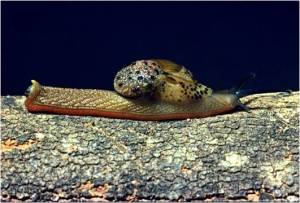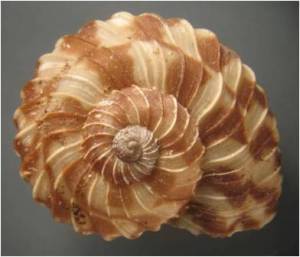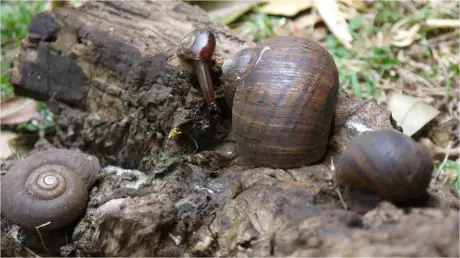 The taxonomy of the Gastropoda is still under revision, and more and more of the old taxonomy is being abandoned, as the results of molecular studies slowly become clearer.
The taxonomy of the Gastropoda is still under revision, and more and more of the old taxonomy is being abandoned, as the results of molecular studies slowly become clearer.
AUSTRALIAN LAND SNAIL TAXONOMY:
PHYLUM MOLLUSCA
CLASS GASTROPODA
SUPERORDER NERITIMORPHA
Superfamily Helicinoidea
- Family Helicinidae
Superfamily Hydrocenoidea
- Family Hydrocenidae
SUPERORDER CAENOGASTROPODA
Superfamily Cyclophoroidea
- Family Cyclophoridae
- Family Pupinidae
- Family Diplommatinidae
Superfamily Rissooidea
- Family Assimineidae
SUPERORDER HETEROBRANCHIA
ORDER SYSTELLOMMATOPHORA
Superfamily Veronicelloidea
- Family Veronicellidae *
- Family Rathouisiidae
ORDER EUPULMONATA
- SUBORDER STYLOMMATOPHORA
INFRAORDER ORTHURETHRA
Superfamily Achatinelloidea
- Family Achatinellidae
Superfamily Cochlicopoidea
- Family Cochlicopidae *
Superfamily Pupilloidea
- Family Pupillidae
- Family Valloniidae *
- Family Pleurodiscidae *
Superfamily Enoidea
- Family Cerastidae **
INFRAORDER SIGMURETHRA
Superfamily Achatinoidea
- Family Ferrussaciidae *
- Family Subulinidae **
Superfamily Testacelloidea
- Family Testacellidae *
Superfamily Rhytidoidea
- Family Rhytididae
Superfamily Streptaxoidea
- Family Streptaxidae *
Superfamily Acavoidea
- Family Caryodidae
Superfamily Orthalicoidea
- Family Bothriembryontidae
- Family Placostylidae
- Family Megaspiridae
Superfamily Arionoidea
- Family Arionidae *
Superfamily Punctoidea
- Family Punctidae
- Family Charopidae
- Family Helicodiscidae
- Family Cystopeltidae
Superfamily Limacoidea
- Family Agriolimacidae *
- Family Limacidae *
- Family Milacidae *
- Family Vitrinidae *
Superfamily Helicarionoidea
- Family Helicarionidae
- Family Microcystidae
Superfamily Gastrodontoidea
- Family Euconulidae **
- Family Oxychilidae *
- Family Pristilomatidae *
- Family Trochomorphidae
- Family Gastrodontidae *
Superfamily Plectopyloidea
- Family Corillidae
Superfamily Helicoidea
- Family Camaenidae
- Family Bradybaenidae *
- Family Helicidae *
- Family Hygromiidae *
- Family Cochlicellidae *
INFRAORDER ELASMOGNATHA
Superfamily Succineoidea
- Family Succineidae **
Superfamily Athoracophorodea
- Family Athoracophoridae
* Introduced species
** Introduced and native species
Common names for land snail families:
- Bradybaenidae [includes Asian Tramp Snail}
- Bothriembryontidae [Tapered Snails]
- Camaenidae [Helicoid Snails]
- Caryodidae [Bush and Panda Snails]
- Charopidae [Pinwheel Snails]
- Cochlicellidae [Pointed Snails]
- Cochlicopidae [Pillar Snails]
- Cyclophoridae [Pendant Snails]
- Cerastidae [Porcelain & thin-shelled Snails]
- Euconulidae [Beehive & Turreted Snails]
- Ferrussaciidae [Needlesnails, Husk & Blind Snails]
- Gastrodontidae [Orchid Snails]
- Helicidae [Introduced and European Snails
- Helicinidae [Droplet-snails]
- Helicodiscidae [Microdisc Snails]
- Helicarionidae [Glass-Snails and Semi-slugs]
- Hydrocenidae [Microturbans]
- Hygromiidae [Vineyard Snails & allies]
- Microcystidae [Tiny Glass-snails]
- Oxchilidae [Garlic & Cellar Snails]
- Pristilomatidae [Crystal Snails]
- Punctidae [Pinhead Snails]
- Pupillidae [Pupasnails]
- Rhytididae [Carnivorous Snails]
- Streptaxidae [Predatory Snails]
- Subulinidae [Awlsnails]
- Succineidae [Amber Snails]
- Trochomorophidae [Squat-keeled Snails]
- Valloniidae [Grass-snails]
- Vitrinidae [Glass-snail]
Common names for slug families:
- Agriolimacidae [Field Slugs & allies]
- Arionidae [Roundback Slugs]
- Athoracophoridae [Red-triangle Slugs]
- Cystopeltidae [Humpback Slugs]
- Limacidae [Leopard Slug & allies]
- Milacidae [Jet Slugs]
- Testacellidae [Earshell Slugs]
- Veronicellidae [Leatherleaf & Brown Slugs]
Genus:
Species: Approximately 2500
In Australia, the two main groups of land snails are:
OPERCULATES
These snails have an open pallial cavity which absorbs oxygen. Most notably, they have only one pair of tentacles. About 130 species can be found in Australia. Three main groups are:
Droplet-snails: Helicinidae
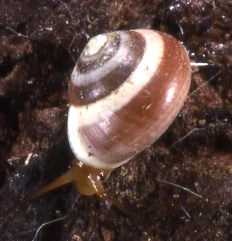
Cape York Droplet Snail Pleuropoma gouldiana (Forbes, 1851)
Pendant Snails: Cyclophoridae
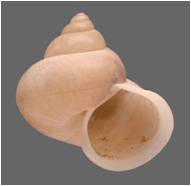
Opalescent Pendant-snail (Leptopoma perlucida)
Microturban Snails: Hydrocenidae
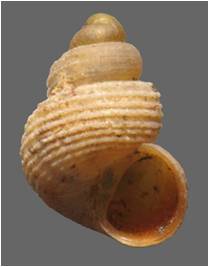
Royal Arch Microturban (Georissa minuta)
PULMONATES
These snails, semi-slugs and slugs have two pairs of tentacles. They breathe using lungs. In Australia, we have about 3000 species.
The more common groups are:
Native slugs: Athoracophoridae
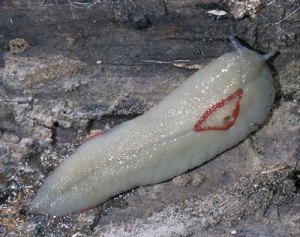
Red-triangle Slug (Triboniophorus graeffei)
Glass-snails and Semi-slugs: Helicarionidae
- Glass-snails: This is a group of semi-slugs and one of the most speciose families.

Chillagoe Glass-snail (Einasleighana antiqua)
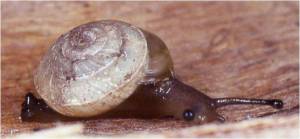
Gayndah Glass-snail (Delinitesta gayndahensis
- Semi-slugs: Semi-slugs are snails that cannot retract into their shell as it is much reduced in size.
Pinwheel snails: Charopidae
Charopids or pinwheel snails are micro-snails (from 1.2-7.0mm) with an estimated 750 Australian species. Charopidae have their greatest diversity in eastern Australia.
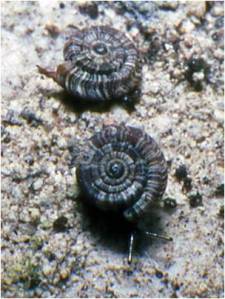
Sunburst Pinwheel Snail (Letomola lanalittleae)
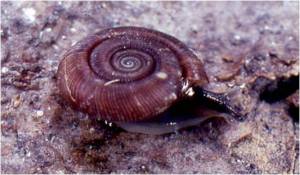
Goodnight Scrub Pinwheel Snail (Gyrocochlea goodnight)
Many Charopids have beautiful shell sculpture when seen under microscopes
Camaenids: Camaenida
Camaenids are generally larger than snails in most other families. In eastern Australia, the stable moisture regime and acidic soils have resulted in the evolution of a number of arboreal species
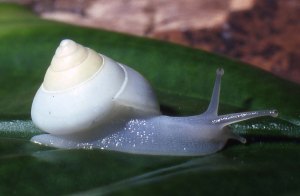
Ivory Treesnail (Noctepuna cerea)
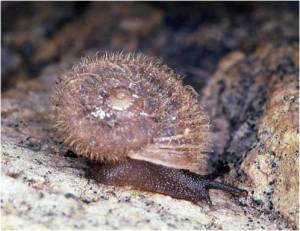
Chillagoe Spiny Snail (Tolgachloritis campbelli)
Some camaenids possess bristles or hair-like structures
Other camaenids have elaborate banding patterns in their shells.
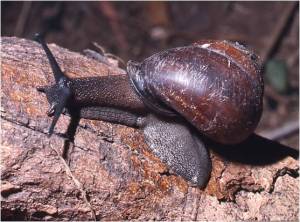
Frasers Banded Snail (Sphaerospira fraseri)
Caryodids: Caryodidae
Caryodids are endemic to eastern Australia and are generally large. They include our largest land snail, the Giant Panda Snail.
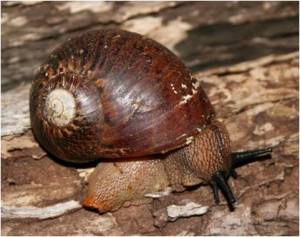
Giant Panda Snail (Hedleyella falconeri)
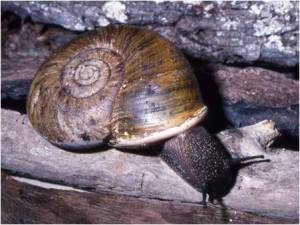
Bundaberg Flat-coiled Snail (Pedinogyra terrycarlessi)
Carnivorous Snails: Rhytididae
The carnivorous snails eat meat and their diet includes a range of invertebrates including other snails. The long neck is a feature of these snails.

Glossy Turban Carnivorous Snail (Terrycarlessia turbinate) dining on an Asian Tramp snail
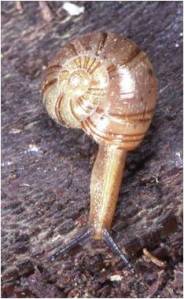
Harriett’s Carnivorous Snail (Austrorhytida harriettae)
